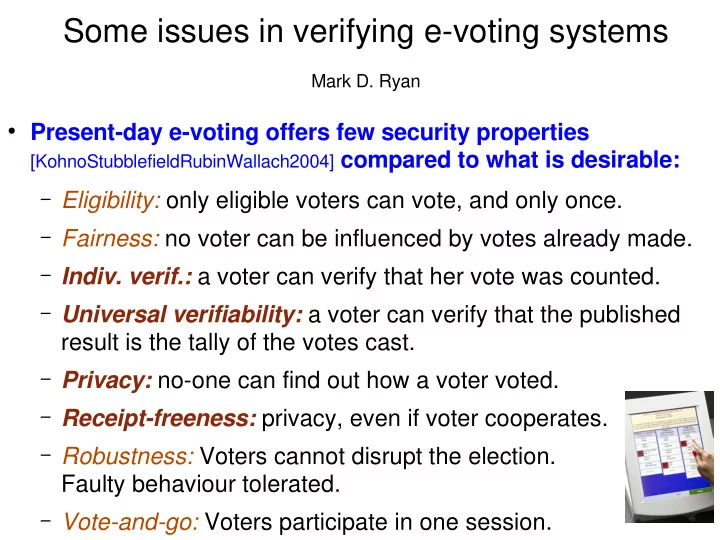

Some issues in verifying e-voting systems Mark D. Ryan ● Present-day e-voting offers few security properties [KohnoStubblefieldRubinWallach2004] compared to what is desirable: – Eligibility: only eligible voters can vote, and only once. – Fairness: no voter can be influenced by votes already made. – Indiv. verif.: a voter can verify that her vote was counted. – Universal verifiability: a voter can verify that the published result is the tally of the votes cast. – Privacy: no-one can find out how a voter voted. – Receipt-freeness: privacy, even if voter cooperates. – Robustness: Voters cannot disrupt the election. Faulty behaviour tolerated. – Vote-and-go: Voters participate in one session.
Some protocols ● Classify according to how they obtain privacy – Anonymous channels and mixing the votes ● Look possible to model DY-style, since generally possible to abstract the crypto. ● E.g. [FujiokaOkamotoOhta1992]; some properties verified [KremerRyan2005] ● E.g. [Chaum P.Ryan Schneider 2005] – Homomorphic encryption ● Look hard to model, since generally dependent on crypto details; not easy to abstract Hard to model designated-verifier proofs ● E.g. [HirtSako 2000]
[FujiokaOkamotoOhta1992] Alice aDministrator Collector { } blind ( commit ( v , c ), b ) − 1 A { } I blind ( commit ( v , c ), b ) − 1 D { } = unblind (...) commit ( v , c ) − 1 D II { } commit ( v , c ) − 1 D publ . ( l , commit ( v , c )) ( c l , ) III = open (...) v publ . v
[Chaum P.Ryan Schneider 2005] Administrator Alice T2k-2 T2k-4 T2 T0 onion offset onion offset + v decr / subtr / mix oni off decr / subtr / mix decr / subtr / mix { } { } { } = onion g , g , ..., g , g , D ... − − 2 k 1 2 k 2 1 0 T T 0 T 1 − 2 k 3 T − 2 k 2 T 2 k − 1 d / s / m v = + + offset h ( g ) ... h ( g ) mod V − 2 k 1 0
● Some systems, and supposed properties Property FOO’92 HS’00 CRS’05 Privacy Blind Homomorphic Anonymising signatures + crypto mix phases Receipt-freeness X Designated- Receipt useless verifier proofs as proof Indiv.verif . Published list X (I think!) X, but high assurance Vote&go No Yes Yes
Issues in modelling the protocols ● Applied-pi and Proverif ● [FOO92] – Blind signatures ● [CRS05] – Modulo arithmetic – Choice of teller sequence ● [HS00] – Designated-verifier re-encryption proofs – 1-out-of-L re-encryption proofs
Should we have e-voting? ● Experience in USA – Proprietary system, not based on disciplined protocol, allegations of involvement of equipment supplier with a political party – “I voted party p1 and the system said `Thank you, we have recorded your vote for party p2.’ ” (Radio phone-ins, websites) – “15 year old in garage could manufacture cards and sell them on the internet that would allow multiple votes” [Avi Rubin] ● Electronic systems potentially allow large scale undetectable fraud – In contrast, fraud in manual systems limited by requirement to generate or dispose of paper, which is quite hard to do undetectably in presence of TV cameras. ● Protocol complexity an obstacle to public confidence – Public confidence is the most important ppty of an election system.
Recommend
More recommend